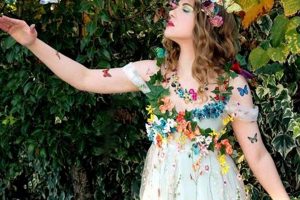Crafting personalized attire and makeup for the Day of the Dead celebrations allows individuals to participate actively in this cultural tradition. The practice involves creating outfits and applying makeup styles that reflect the symbolism and aesthetics associated with the holiday, often emphasizing elements like sugar skulls, floral motifs, and skeletal features. As an example, an individual might create a dress adorned with marigolds and paint their face to resemble a calavera.
This approach offers numerous advantages, including cost savings and the opportunity for creative expression. It allows for a deeper connection to the cultural roots of the celebration, as participants engage in the process of creating their own representations of the deceased. Historically, homemade elements were a significant aspect of Day of the Dead observances, reflecting the resources and creativity of individual families and communities.
The following sections will provide specific guidance on designing and executing distinct elements of Day of the Dead celebrations, including makeup application techniques, outfit construction tips, and options for sourcing materials effectively. These details will facilitate the creation of authentic and personalized presentations for the occasion.
Tips for Creating Day of the Dead Attire
The following guidelines offer practical advice for producing authentic and visually compelling Day of the Dead-themed ensembles. Adhering to these suggestions will enhance the overall impact and respectful representation within the cultural context of the celebration.
Tip 1: Prioritize Authentic Symbolism. Research traditional imagery associated with the holiday, such as marigolds, monarch butterflies, and calaveras. Incorporating these elements accurately reflects the spirit of remembrance and honors the deceased.
Tip 2: Utilize Readily Available Materials. Fabric scraps, recycled clothing, and inexpensive craft supplies can be repurposed effectively. This approach reduces costs and promotes sustainability.
Tip 3: Master Calavera Makeup Techniques. Study tutorials and practice applying face paint to achieve the iconic sugar skull aesthetic. Pay close attention to symmetry, shading, and the use of bold colors.
Tip 4: Incorporate Floral Accents. Create or purchase artificial flower crowns, necklaces, or other adornments. Marigolds are particularly significant and should be prominent if possible.
Tip 5: Consider Regional Variations. Day of the Dead traditions vary across different regions of Mexico. Researching specific regional customs can add authenticity to the attire.
Tip 6: Emphasize Personalization. While adhering to traditional symbols is important, infuse the attire with personal touches that reflect the individual being honored. This might include incorporating their favorite colors, hobbies, or symbols.
Tip 7: Ensure Comfort and Functionality. While visual appeal is important, prioritize comfortable and practical clothing. The attire should allow for ease of movement and participation in the celebration’s activities.
Following these guidelines will result in a respectful, visually striking, and personally meaningful presentation for Day of the Dead observances. This approach enables individuals to engage authentically with this cultural tradition.
The subsequent sections will explore specific makeup tutorials and outfit construction techniques in greater detail, providing a step-by-step guide for creating a complete Day of the Dead ensemble.
1. Authentic symbolism
The effective creation of Day of the Dead attire necessitates a comprehensive understanding and accurate application of traditional symbolism. This ensures respect for the cultural significance of the holiday and enhances the overall impact of the presentation. The subsequent points outline key facets of authentic symbolism within this context.
- Marigolds (Cempaschil)
Marigolds are inextricably linked to Day of the Dead traditions. These flowers are believed to guide the spirits of the deceased back to the world of the living with their vibrant color and scent. In attire, incorporating marigolds, whether real, artificial, or depicted in patterns, conveys this symbolic guidance and remembrance.
- Sugar Skulls (Calaveras de Azcar)
Sugar skulls represent the deceased and are often decorated with intricate designs and the name of the departed. In terms of attire and makeup, the calavera motif is essential. Face painting replicating the sugar skull design transforms the wearer into a symbolic representation of the enduring memory of the dead.
- Monarch Butterflies
Monarch butterflies are believed to embody the spirits of the deceased returning to visit their loved ones. Incorporating monarch butterfly imagery into Day of the Dead attire, through fabric prints, jewelry, or accessories, symbolizes this annual spiritual reunion.
- Skeletal Imagery
Skeletal representations, while seemingly macabre, are a central theme of Day of the Dead. They serve as a reminder of the cyclical nature of life and death. In attire, skeletal designs, such as bone patterns or full skeletal representations, emphasize this philosophical aspect of the celebration, acknowledging mortality with both reverence and humor.
The successful integration of these symbolic elements into attire involves careful selection and respectful representation. The goal is to create a visual narrative that honors the cultural significance of Day of the Dead and effectively conveys the spirit of remembrance and celebration that defines the holiday.
2. Calavera makeup
Calavera makeup constitutes a central and defining element within the broader context of Day of the Dead attire creation. It serves as a critical visual marker, instantly identifying the wearer as participating in the Day of the Dead festivities and embodying the spirit of remembrance. The relationship is one of integral component to comprehensive ensemble; without Calavera makeup, the homemade Day of the Dead costume lacks a crucial aspect of its visual and symbolic power. For example, an individual might construct a full period dress adorned with marigolds, however, without the painted Calavera face, the connection to Day of the Dead will not be immediately obvious to an observer.
The application of Calavera makeup is not merely cosmetic; its an act of transforming the individual into a representation of the deceased, often with elaborate designs and symbolic motifs. The design process often involves researching traditional Calavera styles, such as those originating from specific regions of Mexico, or incorporating elements personalized to honor a specific deceased loved one.
These makeup designs often involve intricate details around the eyes, nose, and mouth, emphasizing the skeletal structure and incorporating floral elements, spider webs, or other symbols associated with the holiday. The time investment and skill involved in applying Calavera makeup reinforces its significance within the homemade Day of the Dead costume. The availability of tutorials, stencils, and specialized makeup products demonstrates the wide accessibility of this art form, encouraging creative and respectful participation.
In summary, Calavera makeup is indispensable for creating a complete and recognizable Day of the Dead presentation. It provides visual clarity, reinforces the symbolic meaning of the holiday, and allows for personalized expression of remembrance. The successful execution of Calavera makeup significantly elevates the overall impact and cultural authenticity of the created attire. Any homemade Day of the Dead ensemble should prioritize proficiency in makeup to achieve the intended effect of celebrating and honoring the deceased.
3. Floral Adornments
Floral adornments are an integral component of Day of the Dead attire, providing a visual representation of the ephemeral nature of life and the enduring connection between the living and the deceased. The inclusion of flowers in self-made Day of the Dead costumes enhances their cultural authenticity and symbolic richness.
- Marigolds (Cempaschl)
Marigolds hold primary significance as the “flower of the dead.” Their vibrant color and potent scent are believed to guide spirits back to the world of the living. In the context of homemade costumes, marigolds are frequently incorporated into headpieces, necklaces, and dress embellishments. For example, constructing a flower crown entirely from marigolds or attaching individual blooms to a dress bodice are common practices. The implications are that the costume not only becomes visually striking but also symbolically potent, aligning with the core traditions of the holiday.
- Other Symbolic Flowers
While marigolds are paramount, other flower varieties can also be included in Day of the Dead attire, often carrying specific symbolic meanings. White flowers, such as lilies or baby’s breath, can represent purity and remembrance. Crimson blooms, like roses, can signify love and devotion. Incorporating these flowers in addition to marigolds adds layers of meaning to the costume. An example would be weaving white lilies into a marigold headpiece to symbolize the purity of the deceased. This nuanced use of floral symbolism enriches the overall message conveyed by the attire.
- Construction Techniques
The methods employed to incorporate floral adornments range from simple to elaborate. Individual flowers can be attached using glue, wire, or thread. Garlands and wreaths can be created using floral tape and wire. For more durable and reusable adornments, artificial flowers may be preferred. Individuals constructing homemade costumes often adapt these techniques to their skill level and available materials. For instance, a novice might opt for pre-made artificial flower garlands, while an experienced crafter might construct intricate headpieces using fresh flowers and wire. This adaptability allows for diverse levels of participation in the creative process.
- Placement and Composition
The strategic placement and arrangement of floral adornments are crucial for achieving a visually balanced and aesthetically pleasing result. Floral elements are commonly featured on the head, around the neck, and on the torso. The composition should complement the overall design of the costume and reflect the individual’s personal style. For example, a minimalist costume might feature a single, striking marigold headpiece, while a more elaborate design could incorporate a profusion of flowers cascading down the bodice. Attention to these details elevates the costume from a simple garment to a work of art.
In conclusion, floral adornments are a vital element in creating authentic and visually compelling Day of the Dead attire. The selection of specific flowers, the construction techniques employed, and the overall composition all contribute to the costume’s symbolic resonance and aesthetic impact. The conscious integration of these floral elements elevates homemade Day of the Dead costumes, transforming them into respectful and meaningful tributes to the deceased.
4. Repurposed materials
The practice of utilizing repurposed materials is intrinsically linked to the creation of Day of the Dead attire. This connection stems from both economic necessity and a cultural emphasis on resourcefulness, particularly within communities where the holiday traditions are deeply rooted. The effect of employing repurposed materials is a reduction in the overall cost of creating a costume, thereby making participation in the festivities more accessible. Furthermore, this practice can contribute to the unique and individualized nature of each costume, differentiating it from mass-produced alternatives. As an example, a worn wedding dress might be transformed into a “La Catrina” gown, its original form obscured by layers of colorful fabric scraps, floral embellishments, and painted details. In this instance, the act of repurposing elevates the costume beyond a mere representation, imbuing it with a history and personal narrative.
The importance of repurposed materials extends beyond mere cost-effectiveness. It aligns with the underlying themes of remembrance and cyclicality inherent to the Day of the Dead. By giving new life to discarded items, participants engage in a symbolic act of transformation, mirroring the belief in the continuation of existence beyond physical death. For instance, old family photographs might be incorporated into a costume, serving as tangible reminders of loved ones who have passed. Similarly, scraps of fabric from clothing worn by deceased relatives could be sewn into the costume, establishing a direct and intimate connection with the past. The practical application of this understanding is evident in community workshops dedicated to crafting Day of the Dead attire from donated materials, fostering a collaborative and sustainable approach to the celebration.
In conclusion, the connection between repurposed materials and Day of the Dead attire is significant, encompassing economic, cultural, and symbolic dimensions. The utilization of discarded items not only reduces costs but also enhances the individuality and emotional resonance of each costume. Challenges associated with this approach might include sourcing suitable materials and developing the necessary crafting skills. However, the benefits of embracing repurposingincreased accessibility, cultural relevance, and environmental sustainabilityfar outweigh the obstacles. The trend toward sustainable practices in costume design suggests that repurposed materials will continue to play a vital role in the creation of Day of the Dead attire for years to come.
5. Regional variations
Regional variations exert considerable influence over approaches to creating attire for Day of the Dead celebrations. These var
iations reflect unique local traditions, available resources, and distinct interpretations of the holiday’s symbolism. Consequently, the process of creating a Day of the Dead costume is often shaped by the specific regional context within which it occurs.
- Oaxaca: Emphasis on Traditional Textiles
In Oaxaca, indigenous textile traditions significantly influence costume design. Elaborate hand-woven fabrics, often incorporating intricate embroidery and regional motifs, are frequently used in the creation of Day of the Dead attire. For example, a woman might construct a traditional Oaxacan blouse (huipil) using techniques passed down through generations, then embellish it with Day of the Dead-specific elements like sugar skull appliqus or marigold embroidery. This emphasis on textile artistry results in costumes that are both visually stunning and deeply rooted in local cultural heritage. The implications are that homemade costumes in Oaxaca are likely to showcase exceptional textile craftsmanship and regional design elements.
- Yucatn: Influence of Mayan Traditions
The Yucatn Peninsula exhibits a blend of Mayan and Spanish traditions that shape Day of the Dead observances. In this region, attire might incorporate elements of traditional Mayan dress, such as the hipil (a loose-fitting white dress) or embroidered blouses. These garments are then often adorned with Day of the Dead motifs. An illustrative instance is the creation of a hipil adorned with hand-painted calaveras or floral designs, reflecting the syncretic nature of the local culture. The effect is that homemade costumes in Yucatn often display a fusion of Mayan and contemporary Day of the Dead aesthetics.
- Michoacn: Focus on Monarch Butterfly Symbolism
Michoacn, known for its monarch butterfly migration, often features this insect prominently in Day of the Dead celebrations. Costumes in this region frequently incorporate monarch butterfly imagery through fabric prints, accessories, or even the application of butterfly-shaped makeup. A practical instance is the creation of a headdress adorned with monarch butterfly wings crafted from felt or paper. This regional emphasis results in homemade costumes that visually represent the connection between the returning spirits and the monarch butterfly migration. The implications are that regional costumes will include a lot of monarch butterfly imageries.
- Mexico City: Modern and Eclectic Interpretations
In Mexico City, a cosmopolitan hub, Day of the Dead attire often reflects a more modern and eclectic approach. While traditional elements are still present, costumes may incorporate contemporary fashion trends, unconventional materials, and diverse artistic influences. An example is the creation of a “La Catrina” costume using recycled materials and incorporating elements of street art. The outcome is that homemade costumes in Mexico City tend to be more experimental and reflect a broader range of creative expressions. The implication is that the regional interpretations will mix classic and contemporary elements.
The preceding examples illustrate how regional variations significantly impact the creation of Day of the Dead attire. When embarking on a “dia de los muertos costume diy” project, researching and understanding the specific traditions and aesthetic preferences of different regions can enhance the authenticity and cultural sensitivity of the finished costume. This approach fosters a deeper appreciation for the multifaceted nature of Day of the Dead celebrations and enables individuals to create more meaningful and respectful tributes to the deceased.
6. Personalization
Personalization is a core tenet of crafting attire for Day of the Dead celebrations. The act of customizing a costume moves beyond simple replication of traditional imagery, allowing for the incorporation of elements that hold specific meaning for the individual or the deceased being honored. The effect of this personalization is a more profound connection to the cultural significance of the holiday, transforming the costume from a generic representation to a deeply personal tribute. For example, an individual might incorporate the favorite colors, hobbies, or professions of a departed loved one into the costume design. This might involve painting musical notes on a sugar skull mask to represent a musician or adorning a dress with miniature tools to symbolize a carpenter. In these instances, personalization elevates the costume beyond a mere visual display, imbuing it with emotional resonance and individual narrative.
Further examples of personalization can be observed in the selection of specific flowers or symbols that held particular significance for the deceased. Instead of solely relying on marigolds, an individual might incorporate lilies to represent purity or roses to symbolize love. Similarly, specific animals, religious icons, or even brand logos that were meaningful to the departed can be integrated into the costume design. The practical application of this personalization often requires research and thoughtful consideration. Individuals might consult family members or friends to gather information about the deceased’s preferences and passions. This research informs the design process, ensuring that the costume accurately reflects the individual being honored. The importance of considering cultural appropriateness is also emphasized; personalization should enhance, not detract from, the overall respect and reverence associated with the Day of the Dead.
In conclusion, personalization is critical for creating authentic and meaningful Day of the Dead attire. It allows for a deeper connection to the cultural traditions of the holiday, transforming the act of costuming into a form of remembrance and celebration. Challenges associated with personalization might include balancing individual expression with cultural sensitivity. However, the benefits of creating a personalized costume, enhanced emotional resonance and a deeper connection to the deceasedfar outweigh the potential obstacles. The increasing emphasis on individual expression in contemporary culture suggests that personalization will continue to play a vital role in shaping Day of the Dead attire in the years to come.
Frequently Asked Questions
The following questions address common inquiries and misconceptions concerning the creation of costumes for Day of the Dead celebrations. The responses aim to provide clarity and ensure respectful participation in this cultural tradition.
Question 1: Is it culturally appropriate for individuals not of Mexican descent to create and wear Day of the Dead attire?
Participation is generally considered acceptable, provided it is approached with respect and a genuine effort to understand the holiday’s significance. Superficial or appropriative representations should be avoided.
Question 2: What are the key symbols that should be included in Day of the Dead attire?
Marigolds, sugar skulls (calaveras), monarch butterflies, and skeletal imagery are central symbols. Incorporating these elements accurately reflects the spirit of remembrance and honors the deceased.
Question 3: Is it acceptable to create a “scary” or “gory” Day of the Dead costume?
While skeletal imagery is common, the focus should be on remembrance and celebration rather than horror or fear. Avoid excessive gore or elements that disrespect the cultural significance of the holiday.
Question 4: How can recycled or repurposed materials be effectively used in Day of the Dead at
tire creation?
Fabric scraps, recycled clothing, and inexpensive craft supplies can be repurposed to create authentic and visually compelling ensembles. This approach reduces costs and promotes sustainability.
Question 5: Where can individuals find reliable resources for learning about Day of the Dead traditions and symbolism?
Academic articles, reputable cultural organizations, and authentic community events offer accurate information. Avoid relying solely on commercial sources or social media, which may perpetuate misinformation.
Question 6: What are some common mistakes to avoid when creating Day of the Dead attire?
Common errors include cultural appropriation, inaccurate portrayal of symbols, and a lack of understanding of the holiday’s traditions. Researching and seeking guidance from cultural experts can help avoid these pitfalls.
Authentic and respectful participation in Day of the Dead celebrations requires thoughtful consideration and a commitment to understanding the holiday’s cultural significance. The act of crafting homemade attire should be approached with reverence and a genuine desire to honor the deceased.
The following section will provide further insights into the historical and cultural context of Day of the Dead traditions, offering a deeper understanding of the holiday’s origins and significance.
Dia de los Muertos Costume DIY
The preceding exploration underscores the multifaceted nature of crafting personalized attire for Day of the Dead celebrations. This activity transcends mere costuming, serving as a tangible expression of cultural understanding, artistic creativity, and personal remembrance. The effective execution of a “dia de los muertos costume diy” project requires meticulous attention to authentic symbolism, regional variations, and individualized elements, ensuring that the final presentation is both visually compelling and culturally respectful.
As Day of the Dead traditions continue to evolve and resonate across diverse communities, the act of crafting unique attire remains a potent means of engaging with the holiday’s core values. Careful consideration of the historical context, cultural nuances, and symbolic representations will enable individuals to create meaningful tributes that honor the deceased and celebrate the enduring cycle of life and death. The continued emphasis on cultural sensitivity and creative expression ensures that the “dia de los muertos costume diy” activity serves as a bridge between the past and present, fostering a deeper appreciation for this profound cultural tradition.



![DIY Hippo Costume: Make Your Own! [Easy Guide] The DIY Hub: Creative Crafts, Repairs & Life Hacks DIY Hippo Costume: Make Your Own! [Easy Guide] | The DIY Hub: Creative Crafts, Repairs & Life Hacks](https://craftingdiycenter.com/wp-content/uploads/2025/07/th-7233-300x200.jpg)


